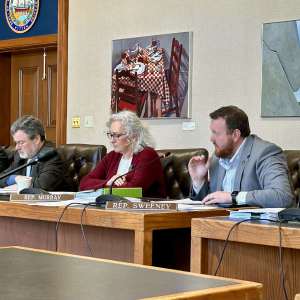Can N.H. government do more with less? Here’s what state leaders say they can and can’t live without.

State Police cruisers parked in front of the New Hampshire Department of Safety headquarters on Hazen Drive in Concord. Paul Cuno-Booth
|
Published: 02-11-2025 7:22 PM
Modified: 02-12-2025 2:45 PM |
State department heads warned in recent months that just meeting the bare minimum legal requirements on their budgets could lead to staff cuts and reduced services. Governor Kelly Ayotte had requested proposals that were 4% less than what they spent this year.
Each agency’s so-called “efficiency” budget requests varied on how specific they were on what could be cut and what they said they couldn’t live without.
Shortly after her election, Ayotte asked agencies to suggest reductions to their budgets as she hoped to trim government spending without taking services away from the New Hampshire residents who need them. She warned of lean times ahead as the state faces revenue shortfalls and costly lawsuits.
That’s all set to come into focus this week, as Ayotte will present her spending plan for the next two years.
While department heads made their case to the state budget committee in November, several said meeting Ayotte’s targets could lead to cuts in various state projects.
Here’s a rundown of how state leaders said government could become leaner and what services they viewed as non-negotiable funding priorities.
This department took the advice from former Gov. Chris Sununu, who said as he left office that state agencies should abandon funding for some of their vacant positions.
The Department of Safety said it could defund 88 vacant positions over the next two years, saving about $8.8 million. At the same time, the department would see a $7 million increase in salary and benefits for existing employees.
Article continues after...
Yesterday's Most Read Articles
 House committee defunds relief program for mothers and children, spares SNAP incentives
House committee defunds relief program for mothers and children, spares SNAP incentives
 No high-speed E-ZPass at Hooksett tolls for at least two months
No high-speed E-ZPass at Hooksett tolls for at least two months
 New Hampshire law enforcement to step up traffic enforcement on Route 106
New Hampshire law enforcement to step up traffic enforcement on Route 106
 Schools in Lakes Region explore creating a special education school to bring down costs
Schools in Lakes Region explore creating a special education school to bring down costs
 Work continues on new state psychiatric hospital in Concord
Work continues on new state psychiatric hospital in Concord
 House committee reverses vote, adopts prohibition on DEI activities and spending
House committee reverses vote, adopts prohibition on DEI activities and spending
The Division of Motor Vehicles warned that reducing staffing could increase wait times for appointments, walk-ins, phone inquiries and transaction processing.
According to its proposal, the New Hampshire State Police would also forego some new equipment, including 72 Chevrolet Tahoes and 67 portable radios for a cost of about $1.8 million.
Helen Hanks, the commissioner of the Department of Corrections, said she’s working with the Department of Health and Human Services to provide re-entry services to people as they leave prison to reduce the state’s rate of reincarceration. That creates a “healthier system” overall, she told the Monitor this week, but it’s also one big way to cut costs inside the state prison. Fewer beds filled means fewer work hours needed to staff them.
In November, she told budget directors that her department has to mandate a great deal of overtime to compensate for a staffing shortage. In 2025 alone, she estimates the department will spend more than $26 million on overtime.
Overtime has the greatest effect on the state’s general fund, she said, and she hopes to cut those costs by reducing prison populations and hiring more staff.
“The interesting reality is, I’m not sure how we cut services for an agency that’s still trying to fill the void of our law enforcement ranks to reduce our overtime,” Hanks told the Monitor. “It would be counterintuitive to do any significant cuts because we would just be [doing] incarceration and no treatment.”
As local and state spending continues to rise, the number of students enrolled in New Hampshire’s public schools is on the decline.
James Gerry, the state’s budget director, asked the education commissioner during hearings: What keeps costs so high?
Frank Edelblut, who runs the Department of Education, said part of the growing cost comes from an increase in administrative roles, he said, including nontraditional ones like school counselors and psychologists.
His department’s proposed “efficiency” budget included a slight decrease for the next year, sticking around $1.54 billion. That amount would increase by about 1.5% in 2027.
Edelblut didn’t identify specific areas where he could reduce spending but assured the budget team he’s already thinking about contingency plans. Multiple lawsuits over education funding are currently hanging over the state, which Edelblut said he hasn’t budgeted for without knowing the outcome. Some could cost the state up to $500 million.
Meanwhile, the University System of New Hampshire and Community College System of New Hampshire said thy could work to keep their budgets flat.
In presentations to the budget committee in November, university Chancellor Katherine Provencher said she tried to trim the budget down to $91.2 million, but she said she hopes it’ll land closer to $95 million.
Most state money is used to offset the price of tuition at the system’s three colleges, Provencher said, which include the University of New Hampshire, Keene State College and Plymouth State University. She warned that budget cuts could lead to tuition increases and, in turn, a struggle to retain students.
“In order to make up this reduction in state support, if we were going to make that up with in-state tuition, that’d be about a 6% increase in in-state tuition, which we cannot do,” Provencher said. “The market cannot bear that type of increase.”
This department, which runs everything from healthcare to housing to family services, is one behemoth of a budget. DHHS accounts for 53% of the money that goes to the 45 agencies, commissions and boards that operate on state funding. It also employs more than one-quarter of all state workers.
Their budget proposal totals more than $3.5 billion each year, with about a third of that coming from the state’s general fund. As the largest agency, its budget is more convoluted than most. It’s unclear as of yet which specific areas could see cuts, if any.
While making some reductions, the department added many funding requests to its budget proposal – some of which are current services that could be on the chopping block.
DHHS leaders requested $18 million to support residential placement contracts in 2027 resulting from a loss in Medicaid funds.
They also requested help from the governor and Legislature to fund programs mandated by state laws. For example, a Senate bill last year expanded access to court-appointed counsel for children involved in dependency cases. DHHS wants $1.5 million annually to support 14 positions in that effort, as well as another $957,000 to fund five new attorneys for the Division of Children, Youth and Families.
William Cass, the transportation commissioner, said he submitted a proposal with the requested cuts – but they don’t come without a real impact on services.
He chose not to fund a state transit match of $1.7 million per year, which is meant to help municipalities meet federal grant requirements. Public transit services may be impeded, he said, including the maintenance and construction of rail trails. That could still be added later by legislators.
He also proposed reducing overtime, foregoing more than $5 million in vehicle service replacements and underfunding winter maintenance by $11 million, which could go out the window with lots of heavy snowfall.
Cass said he does worry that budget cuts could impact maintenance – safety, including winter services, which is his first priority.
“We have met the budget targets to balance the budget, but in many cases we aren’t budgeting for what we need,” Cass said.
Agencies are waiting to see what cuts are included in Ayotte’s draft budget, which will be delivered in her budget address to the Legislature at 10 a.m. on Thursday.







 Henniker ponders what is a ‘need’ and what is a ‘want’
Henniker ponders what is a ‘need’ and what is a ‘want’ Boscawen residents vote to fund major renovation of public works building
Boscawen residents vote to fund major renovation of public works building ‘Voting our wallets’: Loudon residents vote overwhelmingly against $1.7M bond for new fire truck
‘Voting our wallets’: Loudon residents vote overwhelmingly against $1.7M bond for new fire truck In Pembroke, Education Freedom Accounts draw debate, voters pass budget
In Pembroke, Education Freedom Accounts draw debate, voters pass budget
